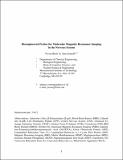| dc.contributor.author | Jasanoff, Alan Pradip | |
| dc.contributor.author | Hsieh, David | |
| dc.date.accessioned | 2014-12-19T20:19:27Z | |
| dc.date.available | 2014-12-19T20:19:27Z | |
| dc.date.issued | 2012-07 | |
| dc.date.submitted | 2012-05 | |
| dc.identifier.issn | 1948-7193 | |
| dc.identifier.uri | http://hdl.handle.net/1721.1/92418 | |
| dc.description.abstract | The development of molecular imaging probes has changed the nature of neurobiological research. Some of the most notable successes have involved the use of biological engineering techniques for the creation of fluorescent protein derivatives for optical imaging, but recent work has also led to a number of bioengineered probes for magnetic resonance imaging (MRI), the preeminent technique for noninvasive investigation of brain structure and function. Molecular MRI agents are beginning to be applied for experiments in the nervous system, where they have the potential to bridge from molecular to systems or organismic levels of analysis. Compared with canonical synthetic small molecule agents, biomolecular or semibiosynthetic MRI contrast agents offer special advantages due to their amenability to molecular engineering approaches, their properties in some cases as catalysts, and their specificity in targeting and ligand binding. Here, we discuss an expanding list of instances where biological engineering techniques have aided in the design of MRI contrast agents and reporter systems, examining both advantages and limitations of these types of probes for studies in the central nervous system. | en_US |
| dc.description.sponsorship | National Institutes of Health (U.S.) (Grant DP2-OD002114) | en_US |
| dc.description.sponsorship | National Institutes of Health (U.S.) (Grant R01-DA028299) | en_US |
| dc.description.sponsorship | Natural Sciences and Engineering Research Council of Canada (Post-Graduate Scholarship) | en_US |
| dc.language.iso | en_US | |
| dc.publisher | American Chemical Society (ACS) | en_US |
| dc.relation.isversionof | http://dx.doi.org/10.1021/cn300059r | en_US |
| dc.rights | Article is made available in accordance with the publisher's policy and may be subject to US copyright law. Please refer to the publisher's site for terms of use. | en_US |
| dc.source | Prof. Jasanoff via Howard Silver | en_US |
| dc.title | Bioengineered Probes for Molecular Magnetic Resonance Imaging in the Nervous System | en_US |
| dc.type | Article | en_US |
| dc.identifier.citation | Hsieh, Vivian, and Alan Jasanoff. “Bioengineered Probes for Molecular Magnetic Resonance Imaging in the Nervous System.” ACS Chemical Neuroscience 3, no. 8 (August 15, 2012): 593–602. | en_US |
| dc.contributor.department | Massachusetts Institute of Technology. Department of Biological Engineering | en_US |
| dc.contributor.department | Massachusetts Institute of Technology. Department of Brain and Cognitive Sciences | en_US |
| dc.contributor.department | Massachusetts Institute of Technology. Department of Chemical Engineering | en_US |
| dc.contributor.department | Massachusetts Institute of Technology. Department of Nuclear Science and Engineering | en_US |
| dc.contributor.approver | Jasanoff, Alan Pradip | en_US |
| dc.contributor.mitauthor | Hsieh, Vivian | en_US |
| dc.contributor.mitauthor | Jasanoff, Alan Pradip | en_US |
| dc.relation.journal | ACS Chemical Neuroscience | en_US |
| dc.eprint.version | Author's final manuscript | en_US |
| dc.type.uri | http://purl.org/eprint/type/JournalArticle | en_US |
| eprint.status | http://purl.org/eprint/status/PeerReviewed | en_US |
| dspace.orderedauthors | Hsieh, Vivian; Jasanoff, Alan | en_US |
| dc.identifier.orcid | https://orcid.org/0000-0002-2834-6359 | |
| dc.identifier.orcid | https://orcid.org/0000-0002-0042-9195 | |
| mit.license | PUBLISHER_POLICY | en_US |
| mit.metadata.status | Complete | |
